The filling and dispensing system for nuclear medicine market is expected to grow from USD 180.3 million in 2025 to USD 407.6 million by 2035, and this expansion is shaped by several notable trends. A key trend is the shift toward full automation in radiopharmaceutical preparation and dose dispensing, driven by the need to reduce manual handling of radioactive materials and minimize radiation exposure for pharmacy and clinical staff. Automated shielded dispensing units are increasingly being integrated into hospital radiopharmacies and centralized manufacturing centers, improving both workflow efficiency and operator safety. The rise of dose-on-demand production models is also influencing equipment design, as facilities require flexible systems that support precise patient-specific dosing with traceable recordkeeping.
Another major trend is the increasing adoption of closed-system sterile handling technologies, which help maintain radiochemical purity and prevent contamination during dose preparation. Integration with quality assurance, dose calibration, and barcoded patient-matching systems is becoming a standard requirement as healthcare providers prioritize regulatory compliance and error prevention. Digital connectivity, remote monitoring, and predictive maintenance features are also becoming more common, enabling tighter control over production environments. Additionally, growth in PET and SPECT-based diagnostic procedures, particularly in oncology and neurology, is expanding the installed base of dispensing systems that support short half-life isotopes, reinforcing demand across both developed and emerging healthcare markets.
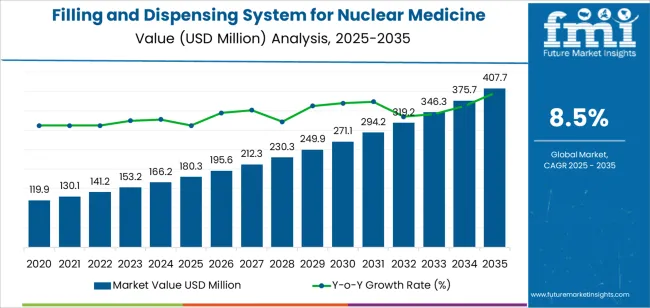
The latter half (2030-2035) will witness continued growth from USD 271.1 million to USD 407.6 million, representing an addition of USD 136.5 million or 60% of the decade's expansion. This period will be defined by mass market penetration of automated dispensing technologies, integration with comprehensive quality management platforms, and seamless compatibility with existing radiopharmacy infrastructure. The market trajectory signals fundamental shifts in how nuclear medicine facilities approach radiopharmaceutical preparation and radiation safety management, with participants positioned to benefit from growing demand across multiple automation levels and application segments.
| Period | Primary Revenue Buckets | Share | Notes |
|---|---|---|---|
| Today | New system sales (fully automatic, semi-automatic) | 46% | Capex-led, radiopharmacy expansion purchases |
| Shielding components & accessories | 26% | Lead glass, tungsten shields, vial shields | |
| Service & maintenance contracts | 18% | Calibration support, radiation testing | |
| Upgrades & retrofits | 10% | Automation enhancement, capacity expansion | |
| Future (3-5 yrs) | Fully automatic systems | 42-47% | AI integration, robotic dispensing |
| Digital monitoring & safety | 16-20% | Real-time dose tracking, contamination detection | |
| Service-as-a-subscription | 14-18% | Performance guarantees, compliance support | |
| Shielding & consumables | 12-16% | Advanced materials, disposable components | |
| Validation & compliance services | 8-12% | Regulatory support, quality documentation | |
| Data services | 4-6% | Dose optimization, workflow analytics |
| Metric | Value |
|---|---|
| Market Value (2025) | USD 180.3 million |
| Market Forecast (2035) | USD 407.6 million |
| Growth Rate | 8.5% CAGR |
| Leading Technology | Fully Automatic Systems |
| Primary Application | Pharmaceutical Segment |
The market demonstrates strong fundamentals with fully automatic dispensing systems capturing a dominant share through advanced radiation protection capabilities and radiopharmaceutical production optimization. Pharmaceutical applications drive primary demand, supported by increasing radiopharmaceutical manufacturing and nuclear medicine diagnostic requirements. Geographic expansion remains concentrated in developed markets with established nuclear medicine infrastructure, while emerging economies show accelerating adoption rates driven by healthcare modernization initiatives and rising diagnostic standards.
Primary Classification: The market segments by automation level into fully automatic, semi-automatic, and manual dispensing systems, representing the evolution from basic handling equipment to sophisticated production solutions for comprehensive radiopharmaceutical preparation optimization.
Secondary Classification: Application segmentation divides the market into pharmaceutical, hospital, and research sectors, reflecting distinct requirements for production volume, operational efficiency, and radiation safety standards.
Regional Classification: Geographic distribution covers North America, Latin America, Western Europe, Eastern Europe, East Asia, South Asia Pacific, and Middle East & Africa, with developed markets leading adoption while emerging economies show accelerating growth patterns driven by nuclear medicine expansion programs.
The segmentation structure reveals technology progression from standard dispensing equipment toward sophisticated production systems with enhanced automation and radiation protection capabilities, while application diversity spans from pharmaceutical facilities to hospital radiopharmacies requiring precise radiopharmaceutical handling solutions.

Market Position: Fully Automatic dispensing systems command the leading position in the filling and dispensing system for nuclear medicine market with 64% market share through advanced radiation protection features, including superior shielding design, operational efficiency, and radiopharmaceutical production optimization that enable facilities to achieve optimal dose consistency across diverse pharmaceutical and hospital environments.
Value Drivers: The segment benefits from radiopharmacy preference for reliable dispensing systems that provide consistent dose performance, reduced radiation exposure, and operational efficiency optimization without requiring significant infrastructure modifications. Advanced design features enable automated quality control systems, dose accuracy, and integration with existing radiopharmacy equipment, where operational performance and regulatory compliance represent critical facility requirements.
Competitive Advantages: Fully Automatic dispensing systems differentiate through proven operational reliability, consistent dosing characteristics, and integration with automated radiopharmacy systems that enhance facility effectiveness while maintaining optimal radiation safety standards suitable for diverse pharmaceutical and hospital applications.
Key market characteristics:
Semi-Automatic dispensing systems maintain a 28% market position in the filling and dispensing system for nuclear medicine market due to their balanced automation properties and cost advantages. These systems appeal to facilities requiring moderate production capacity with competitive pricing for mid-scale radiopharmacy applications. Market growth is driven by hospital expansion, emphasizing reliable dispensing solutions and operational efficiency through optimized system designs.
Manual dispensing systems capture 8% market share through specialized handling requirements in research facilities, small-batch production, and development applications. These facilities demand flexible dispensing systems capable of handling diverse radiopharmaceuticals while providing effective handling capabilities and operational simplicity.
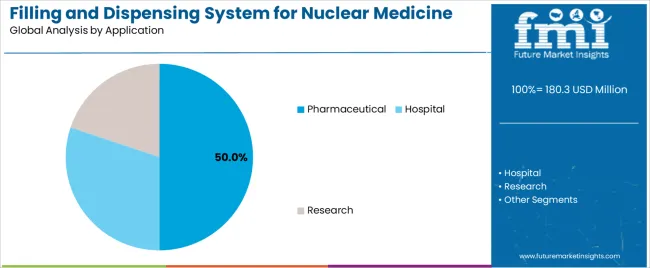
Market Context: Pharmaceutical applications demonstrate the highest growth rate in the filling and dispensing system for nuclear medicine market with 9.2% CAGR due to widespread adoption of automated production systems and increasing focus on radiopharmaceutical manufacturing optimization, operational safety efficiency, and production capacity applications that maximize output while maintaining quality standards.
Appeal Factors: Pharmaceutical facility operators prioritize system automation, production throughput, and integration with existing manufacturing infrastructure that enables coordinated dispensing operations across multiple production lines. The segment benefits from substantial pharmaceutical investment and radiopharmaceutical development programs that emphasize the acquisition of automated systems for production optimization and manufacturing efficiency applications.
Growth Drivers: Radiopharmaceutical expansion programs incorporate automated dispensing systems as standard equipment for production operations, while theranostic development growth increases demand for flexible capacity capabilities that comply with quality standards and minimize radiation exposure.
Market Challenges: Varying production requirements and radioisotope handling complexity may limit system standardization across different facilities or product scenarios.
Application dynamics include:
Hospital applications capture market share through comprehensive radiopharmacy requirements in nuclear medicine departments, diagnostic imaging services, and therapy applications. These facilities demand reliable dispensing systems capable of operating with diverse radiopharmaceuticals while providing effective dose preparation and operational safety capabilities.
Research applications account for market share, including academic institutions, radiopharmaceutical development, and preclinical research requiring specialized dispensing capabilities for experimental formulations and quality control.
| Category | Factor | Impact | Why It Matters |
|---|---|---|---|
| Driver | Growing nuclear medicine procedures & diagnostic imaging demand (PET/SPECT growth, oncology applications) | ★★★★★ | Expanding diagnostic volumes require efficient radiopharmaceutical preparation; automated dispensing becomes essential for throughput and radiation safety. |
| Driver | Regulatory compliance & radiation safety requirements (NRC, IAEA standards) | ★★★★★ | Turns advanced dispensing systems from "optional" to "mandatory"; vendors that provide validation support and compliance documentation gain competitive advantage. |
| Driver | Theranostic radiopharmaceutical development & personalized medicine (targeted therapies, precision dosing) | ★★★★☆ | Novel radiopharmaceuticals need specialized handling; demand for flexible, precise dispensing solutions expanding addressable market. |
| Restraint | High capital investment & validation costs (especially for fully automatic systems) | ★★★★☆ | Small hospitals and research facilities defer purchases; increases price sensitivity and slows automated equipment adoption in resource-limited settings. |
| Restraint | Complex regulatory approval & facility requirements (radiation licensing, infrastructure needs) | ★★★☆☆ | Radiopharmacy facilities face lengthy approval procedures and infrastructure requirements, limiting operational flexibility and increasing implementation complexity. |
| Trend | Automation & robotics integration | ★★★★★ | Robotic dispensing, automated quality control, and AI-driven dose optimization transform operations; full automation and digital integration become core value propositions. |
| Trend | Decentralized radiopharmacy & point-of-care production | ★★★★☆ | Compact dispensing systems for satellite facilities; modular designs and mobile solutions drive competition toward distributed production models. |
The filling and dispensing system for nuclear medicine market demonstrates varied regional dynamics with Growth Leaders including China (11.5% growth rate) and India (10.6% growth rate) driving expansion through nuclear medicine development initiatives and healthcare infrastructure programs. Steady Performers encompass Germany (9.8% growth rate), Brazil (8.9% growth rate), and developed regions, benefiting from established nuclear medicine networks and radiopharmacy technology adoption. Emerging Markets feature United States (8.1% growth rate) and developed regions, where radiopharmaceutical advancement and regulatory standardization support consistent growth patterns.
Regional synthesis reveals East Asian markets leading adoption through nuclear medicine expansion and radiopharmacy development, while South Asian countries maintain rapid expansion supported by healthcare modernization and diagnostic imaging requirements. North American markets show steady growth driven by radiopharmaceutical applications and quality integration trends.
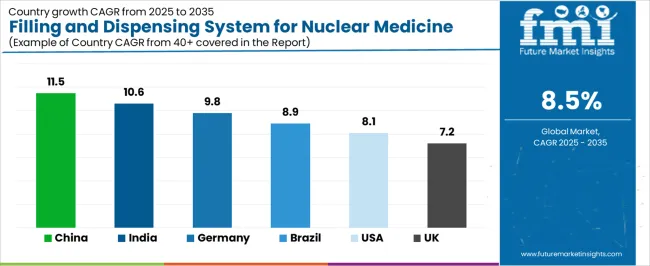
| Region/Country | 2025-2035 Growth | How to win | What to watch out |
|---|---|---|---|
| China | 11.5% | Focus on automation solutions | Regulatory changes; localization requirements |
| India | 10.6% | Lead with cost-effective systems | Infrastructure gaps; skilled workforce shortage |
| Germany | 9.8% | Provide premium safety systems | Regulatory complexity; validation costs |
| Brazil | 8.9% | Value-oriented models | Import duties; currency fluctuations |
| U.S. | 8.1% | Offer compliance support | FDA requirements; competitive pressure |
| U.K. | 7.2% | Push digital integration | NHS budget constraints; procurement cycles |
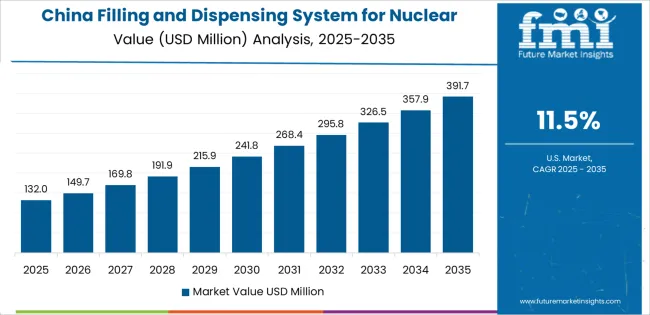
China establishes fastest market growth through aggressive nuclear medicine development programs and comprehensive radiopharmaceutical production capacity expansion, integrating advanced filling and dispensing systems as standard components in pharmaceutical manufacturing and hospital radiopharmacy installations. The country's 11.5% growth rate reflects government initiatives promoting nuclear medicine infrastructure and healthcare technology development that mandate the use of advanced dispensing systems in pharmaceutical and hospital facilities. Growth concentrates in major metropolitan centers, including Beijing, Shanghai, and Guangzhou, where nuclear medicine technology development showcases integrated dispensing systems that appeal to radiopharmacy operators seeking advanced production optimization capabilities and radiation safety applications.
Chinese manufacturers are developing cost-effective dispensing solutions that combine domestic production advantages with advanced operational features, including automated shielding systems and enhanced safety capabilities. Distribution channels through medical equipment suppliers and radiopharmacy service distributors expand market access, while government support for nuclear medicine development supports adoption across diverse pharmaceutical and hospital segments.
Strategic Market Indicators:
In Mumbai, Delhi, and Bangalore, hospital facilities and pharmaceutical operations are implementing advanced filling and dispensing systems as standard equipment for radiopharmaceutical preparation and nuclear medicine applications, driven by increasing government healthcare investment and diagnostic infrastructure modernization programs that emphasize the importance of radiation safety capabilities. The market holds a 10.6% growth rate, supported by government healthcare initiatives and nuclear medicine development programs that promote advanced dispensing systems for hospital and pharmaceutical facilities. Indian operators are adopting dispensing systems that provide consistent operational performance and safety compliance features, particularly appealing in urban regions where radiation protection and dose accuracy represent critical operational requirements.
Market expansion benefits from growing nuclear medicine capabilities and technology transfer agreements that enable domestic production of dispensing systems for hospital and pharmaceutical applications. Technology adoption follows patterns established in medical equipment, where reliability and safety drive procurement decisions and operational deployment.
Market Intelligence Brief:
Germany establishes technology leadership through comprehensive nuclear medicine programs and advanced radiopharmacy infrastructure development, integrating filling and dispensing systems across pharmaceutical and hospital applications. The country's 9.8% growth rate reflects established nuclear medicine relationships and mature dispensing technology adoption that supports widespread use of automated systems in pharmaceutical and hospital radiopharmacy facilities. Growth concentrates in major medical centers, including Baden-Württemberg, Bavaria, and North Rhine-Westphalia, where medical technology showcases advanced dispensing deployment that appeals to radiopharmacy operators seeking proven safety capabilities and operational efficiency applications.
German equipment providers leverage established distribution networks and comprehensive service capabilities, including validation programs and maintenance support that create customer relationships and operational advantages. The market benefits from mature regulatory standards and nuclear medicine requirements that mandate dispensing system use while supporting technology advancement and operational optimization.
Market Intelligence Brief:
Brazil's market expansion benefits from diverse nuclear medicine demand, including radiopharmacy modernization in São Paulo and Rio de Janeiro, hospital facility upgrades, and government healthcare programs that increasingly incorporate dispensing solutions for radiation safety applications. The country maintains a 8.9% growth rate, driven by rising nuclear medicine activity and increasing recognition of automated dispensing benefits, including radiation exposure reduction and enhanced operational efficiency.
Market dynamics focus on cost-effective dispensing solutions that balance advanced operational performance with affordability considerations important to Brazilian healthcare operators. Growing nuclear medicine infrastructure creates continued demand for modern dispensing systems in new facility development and radiopharmacy modernization projects.
Strategic Market Considerations:
United States establishes market leadership through comprehensive nuclear medicine programs and advanced radiopharmacy infrastructure development, integrating filling and dispensing systems across pharmaceutical and hospital applications. The country's 8.1% growth rate reflects established nuclear medicine relationships and mature dispensing technology adoption that supports widespread use of automated systems in pharmaceutical and hospital radiopharmacy facilities. Growth concentrates in major medical centers, including the Northeast, Midwest, and West Coast regions, where medical technology showcases mature dispensing deployment that appeals to radiopharmacy operators seeking proven safety capabilities and regulatory compliance applications.
American equipment providers leverage established distribution networks and comprehensive service capabilities, including validation programs and compliance support that create customer relationships and operational advantages. The market benefits from mature regulatory standards and nuclear medicine requirements that mandate dispensing system use while supporting technology advancement and radiation safety optimization.
Market Intelligence Brief:
United Kingdom's nuclear medicine market demonstrates filling and dispensing system deployment with documented operational effectiveness in hospital applications and pharmaceutical facilities through integration with existing radiopharmacy systems and nuclear medicine infrastructure. The country leverages healthcare expertise in nuclear medicine technology and safety systems integration to maintain a 7.2% growth rate. Medical centers, including London, Manchester, and Birmingham, showcase installations where dispensing systems integrate with comprehensive radiopharmacy platforms and facility management systems to optimize production operations and safety effectiveness.
British healthcare providers prioritize system safety and NHS compliance in dispensing equipment procurement, creating demand for reliable systems with advanced features, including facility monitoring integration and automated safety systems. The market benefits from established nuclear medicine infrastructure and a commitment to invest in radiopharmacy technologies that provide operational benefits and compliance with national healthcare standards.
Market Intelligence Brief:
The European filling and dispensing system for nuclear medicine market is projected to grow from USD 68.2 million in 2025 to USD 135.6 million by 2035, registering a CAGR of 7.1% over the forecast period. Germany is expected to maintain its leadership position with a 36.4% market share in 2025, supported by its advanced nuclear medicine infrastructure and comprehensive radiopharmacy technology adoption.
France follows with a 26.8% share in 2025, driven by nuclear medicine modernization initiatives and radiopharmaceutical production requirements. The United Kingdom holds a 19.9% share through established hospital radiopharmacy networks and regulatory standards. Italy commands a 9.7% share, while Spain accounts for 5.4% in 2025. The rest of Europe region is anticipated to gain momentum, expanding its collective share from 1.8% to 2.6% by 2035, attributed to increasing nuclear medicine adoption in Nordic countries and emerging Eastern European facilities implementing radiopharmacy modernization programs.
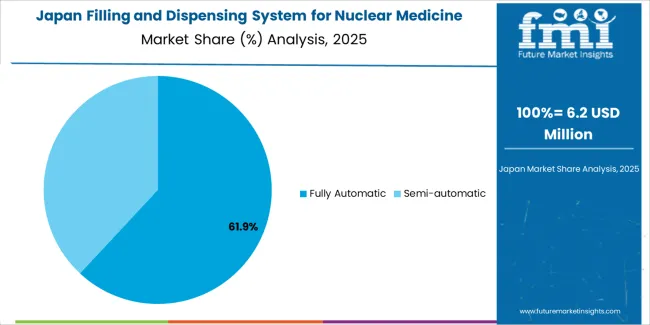
Japan demonstrates advanced nuclear medicine integration in filling and dispensing systems with comprehensive deployment across hospital radiopharmacies and pharmaceutical facilities. The country maintains steady growth through healthcare quality emphasis and radiation safety precision requirements that support adoption of automated dispensing systems. Japanese hospital facilities prioritize accuracy and reliability in radiopharmacy equipment procurement, creating consistent demand for premium systems with advanced shielding capabilities. Market characteristics include high adoption rates in urban medical centers, established regulatory standards, and integration with comprehensive hospital information systems that optimize radiopharmaceutical workflows and nuclear medicine programs.
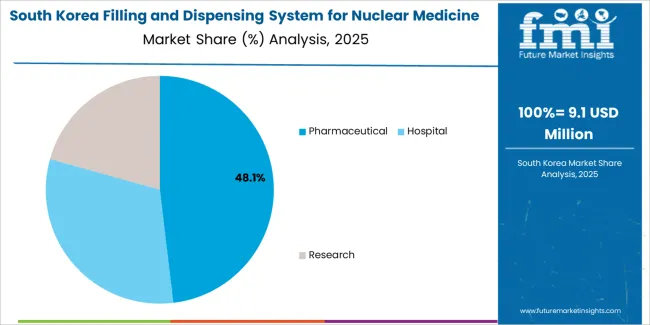
South Korea establishes healthcare innovation leadership through rapid adoption of advanced nuclear medicine technologies and comprehensive hospital modernization programs. The country leverages technology infrastructure and digital healthcare initiatives to support filling and dispensing system deployment across major hospital networks and pharmaceutical facilities. Korean hospital facilities emphasize automation and safety capabilities, driving demand for fully automatic systems with advanced radiation monitoring. Market growth benefits from government healthcare investment, technology-focused procurement standards, and increasing emphasis on nuclear medicine development that position South Korea as a leading market for advanced radiopharmacy solutions.
The filling and dispensing system for nuclear medicine market maintains a moderately consolidated structure with 10-15 credible players, where the top 4-5 companies hold approximately 65-72% market share by revenue. Leadership is maintained through comprehensive product portfolios spanning multiple automation levels and shielding configurations, established radiopharmacy relationships, and global service networks that provide validation support, regulatory compliance assistance, and technical training programs. Market leaders differentiate through technological innovation combining automated dispensing capabilities with advanced radiation protection systems, while also offering seamless integration with laboratory information management systems and radiopharmacy workflow platforms.
Basic dispensing mechanisms and standard shielding protocols are commoditizing, shifting competitive advantage toward value-added services including digital dose monitoring, predictive maintenance analytics, and comprehensive compliance documentation. Margin opportunities concentrate in recurring revenue streams from maintenance contracts, shielding component replacements, and service programs with performance guarantees, along with digital connectivity services that enable real-time radiation exposure tracking and quality assurance integration. Companies investing in robotic automation platforms and artificial intelligence-driven dose optimization systems position themselves for premium market segments, while those focusing on modular designs and cost-effective automation solutions capture growth in emerging markets and smaller hospital radiopharmacies.
Strategic partnerships between system manufacturers and radiopharmaceutical companies create synergies in drug development and companion dispensing applications. The competitive landscape reveals increasing emphasis on total radiopharmacy solutions rather than standalone equipment, with successful players offering comprehensive packages that address diverse handling needs across pharmaceutical manufacturing, hospital radiopharmacies, and research facilities. Technology convergence between traditional manual dispensing and fully automated robotic systems creates opportunities for companies with integrated platforms, while regulatory compliance capabilities and radiation safety expertise remain fundamental requirements for market participation across developed nuclear medicine systems.
| Stakeholder | What they actually control | Typical strengths | Typical blind spots |
|---|---|---|---|
| Global platforms | Distribution reach, comprehensive product lines, service networks | Broad availability, proven reliability, multi-region support | Technology refresh cycles; emerging market adaptation |
| Technology innovators | R&D capabilities; automation systems; advanced shielding | Latest features first; attractive ROI on safety and efficiency | Service density outside core regions; customization complexity |
| Regional specialists | Local compliance, rapid delivery, nearby support | Close radiopharmacy relationships; pragmatic pricing; local regulations | Technology gaps; talent retention in service |
| Service-focused ecosystems | Validation support, maintenance SLAs, compliance programs | Lowest operational disruption; comprehensive support | Service costs if overpromised; technology obsolescence |
| Niche specialists | Specialized applications, research solutions, custom designs | Win research and development applications; flexible configurations | Scalability limitations; narrow market focus |

| Item | Value |
|---|---|
| Quantitative Units | USD 180.3 million |
| Automation Level | Fully Automatic, Semi-automatic |
| Application | Pharmaceutical, Hospital, Research |
| Regions Covered | North America, Latin America, Western Europe, Eastern Europe, East Asia, South Asia Pacific, Middle East & Africa |
| Countries Covered | United States, China, Germany, India, United Kingdom, Japan, Brazil, France, South Korea, Canada, and 25+ additional countries |
| Key Companies Profiled | Comecer S.p.A., Tema Sinergie, Trasis, Norer Shield Medical, Mirion, Ultraray Radiation Protection, Von Gahlen, Lemer Pax, LabLogic Systems, PBL, Universad Giken, Beijing Zhonghe Yongtai Technology, Bequerel & Sievert, Beijing Goyuan New Technology, Sunvic |
| Additional Attributes | Dollar sales by automation level and application categories, regional adoption trends across East Asia, South Asia Pacific, and North America, competitive landscape with nuclear medicine equipment manufacturers and radiopharmacy suppliers, hospital operator preferences for radiation safety and system reliability, integration with radiopharmacy platforms and quality monitoring systems, innovations in automation technology and shielding enhancement, and development of automated dispensing solutions with enhanced performance and radiation protection optimization capabilities. |
The global filling and dispensing system for nuclear medicine market is estimated to be valued at USD 180.3 million in 2025.
The market size for the filling and dispensing system for nuclear medicine market is projected to reach USD 407.7 million by 2035.
The filling and dispensing system for nuclear medicine market is expected to grow at a 8.5% CAGR between 2025 and 2035.
The key product types in filling and dispensing system for nuclear medicine market are fully automatic and semi-automatic.
In terms of application, pharmaceutical segment to command 50.0% share in the filling and dispensing system for nuclear medicine market in 2025.






Full Research Suite comprises of:
Market outlook & trends analysis
Interviews & case studies
Strategic recommendations
Vendor profiles & capabilities analysis
5-year forecasts
8 regions and 60+ country-level data splits
Market segment data splits
12 months of continuous data updates
DELIVERED AS:
PDF EXCEL ONLINE
Filling Fats Market Size, Growth, and Forecast for 2025 to 2035
Filling and Sealing Machine Market Size and Share Forecast Outlook 2025 to 2035
Industry Share Analysis for Fillings and Toppings Companies
Cup Filling Machines Market Forecast and Outlook 2025 to 2035
Box Filling Machine Market from 2025 to 2035
Drum Filling Machine Market Size and Share Forecast Outlook 2025 to 2035
Wine Filling Machine Market Size and Share Forecast Outlook 2025 to 2035
Tube Filling Machine Market Size and Share Forecast Outlook 2025 to 2035
Market Share Distribution Among Tube Filling Machine Manufacturers
Acid Filling and Leveling Machine Market Size and Share Forecast Outlook 2025 to 2035
Vial Filling and Capping Machines Market
Paste Filling Machine Market Analysis - Size, Share, and Forecast Outlook 2025 to 2035
Liquid Filling Machine Market Size and Share Forecast Outlook 2025 to 2035
Bottle Filling Machines Market Size and Share Forecast Outlook 2025 to 2035
Capsule Filling Machines Market Size and Share Forecast Outlook 2025 to 2035
Granule Filling Machine Market Size and Share Forecast Outlook 2025 to 2035
Denture Filling Materials Market Size and Share Forecast Outlook 2025 to 2035
Aerosol Filling Machines Market Size and Share Forecast Outlook 2025 to 2035
Perfume Filling Machine Market Report – Trends, Demand & Industry Forecast 2025-2035
Market Share Breakdown of Capsule Filling Machine Manufacturers

Thank you!
You will receive an email from our Business Development Manager. Please be sure to check your SPAM/JUNK folder too.
Chat With
MaRIA